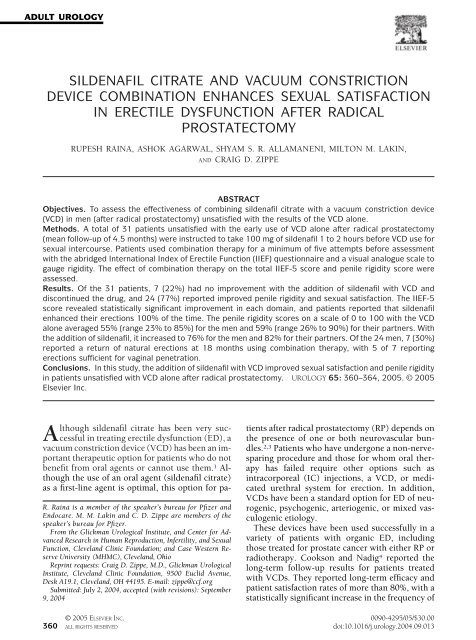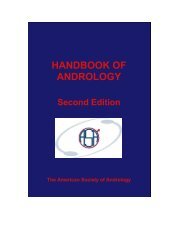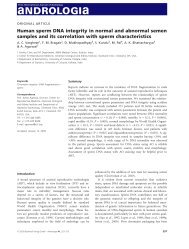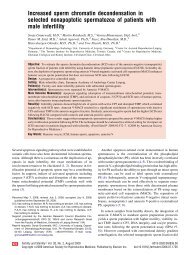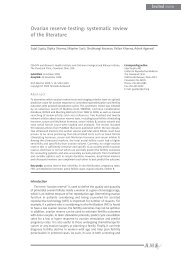sildenafil citrate and vacuum constriction device ... - Cleveland Clinic
sildenafil citrate and vacuum constriction device ... - Cleveland Clinic
sildenafil citrate and vacuum constriction device ... - Cleveland Clinic
You also want an ePaper? Increase the reach of your titles
YUMPU automatically turns print PDFs into web optimized ePapers that Google loves.
ADULT UROLOGY<br />
SILDENAFIL CITRATE AND VACUUM CONSTRICTION<br />
DEVICE COMBINATION ENHANCES SEXUAL SATISFACTION<br />
IN ERECTILE DYSFUNCTION AFTER RADICAL<br />
PROSTATECTOMY<br />
RUPESH RAINA, ASHOK AGARWAL, SHYAM S. R. ALLAMANENI, MILTON M. LAKIN,<br />
AND CRAIG D. ZIPPE<br />
ABSTRACT<br />
Objectives. To assess the effectiveness of combining <strong>sildenafil</strong> <strong>citrate</strong> with a <strong>vacuum</strong> <strong>constriction</strong> <strong>device</strong><br />
(VCD) in men (after radical prostatectomy) unsatisfied with the results of the VCD alone.<br />
Methods. A total of 31 patients unsatisfied with the early use of VCD alone after radical prostatectomy<br />
(mean follow-up of 4.5 months) were instructed to take 100 mg of <strong>sildenafil</strong> 1 to 2 hours before VCD use for<br />
sexual intercourse. Patients used combination therapy for a minimum of five attempts before assessment<br />
with the abridged International Index of Erectile Function (IIEF) questionnaire <strong>and</strong> a visual analogue scale to<br />
gauge rigidity. The effect of combination therapy on the total IIEF-5 score <strong>and</strong> penile rigidity score were<br />
assessed.<br />
Results. Of the 31 patients, 7 (22%) had no improvement with the addition of <strong>sildenafil</strong> with VCD <strong>and</strong><br />
discontinued the drug, <strong>and</strong> 24 (77%) reported improved penile rigidity <strong>and</strong> sexual satisfaction. The IIEF-5<br />
score revealed statistically significant improvement in each domain, <strong>and</strong> patients reported that <strong>sildenafil</strong><br />
enhanced their erections 100% of the time. The penile rigidity scores on a scale of 0 to 100 with the VCD<br />
alone averaged 55% (range 23% to 85%) for the men <strong>and</strong> 59% (range 26% to 90%) for their partners. With<br />
the addition of <strong>sildenafil</strong>, it increased to 76% for the men <strong>and</strong> 82% for their partners. Of the 24 men, 7 (30%)<br />
reported a return of natural erections at 18 months using combination therapy, with 5 of 7 reporting<br />
erections sufficient for vaginal penetration.<br />
Conclusions. In this study, the addition of <strong>sildenafil</strong> with VCD improved sexual satisfaction <strong>and</strong> penile rigidity<br />
in patients unsatisfied with VCD alone after radical prostatectomy. UROLOGY 65: 360–364, 2005. © 2005<br />
Elsevier Inc.<br />
R. Raina is a member of the speaker’s bureau for Pfizer <strong>and</strong><br />
Endocare. M. M. Lakin <strong>and</strong> C. D. Zippe are members of the<br />
speaker’s bureau for Pfizer.<br />
From the Glickman Urological Institute, <strong>and</strong> Center for Advanced<br />
Research in Human Reproduction, Infertility, <strong>and</strong> Sexual<br />
Function, Clevel<strong>and</strong> <strong>Clinic</strong> Foundation; <strong>and</strong> Case Western Reserve<br />
University (MHMC), Clevel<strong>and</strong>, Ohio<br />
Reprint requests: Craig D. Zippe, M.D., Glickman Urological<br />
Institute, Clevel<strong>and</strong> <strong>Clinic</strong> Foundation, 9500 Euclid Avenue,<br />
Desk A19.1, Clevel<strong>and</strong>, OH 44195. E-mail: zippe@ccf.org<br />
Submitted: July 2, 2004, accepted (with revisions): September<br />
9, 2004<br />
Although <strong>sildenafil</strong> <strong>citrate</strong> has been very successful<br />
in treating erectile dysfunction (ED), a<br />
<strong>vacuum</strong> <strong>constriction</strong> <strong>device</strong> (VCD) has been an important<br />
therapeutic option for patients who do not<br />
benefit from oral agents or cannot use them. 1 Although<br />
the use of an oral agent (<strong>sildenafil</strong> <strong>citrate</strong>)<br />
as a first-line agent is optimal, this option for patients<br />
after radical prostatectomy (RP) depends on<br />
the presence of one or both neurovascular bundles.<br />
2,3 Patients who have undergone a non-nervesparing<br />
procedure <strong>and</strong> those for whom oral therapy<br />
has failed require other options such as<br />
intracorporeal (IC) injections, a VCD, or medicated<br />
urethral system for erection. In addition,<br />
VCDs have been a st<strong>and</strong>ard option for ED of neurogenic,<br />
psychogenic, arteriogenic, or mixed vasculogenic<br />
etiology.<br />
These <strong>device</strong>s have been used successfully in a<br />
variety of patients with organic ED, including<br />
those treated for prostate cancer with either RP or<br />
radiotherapy. Cookson <strong>and</strong> Nadig 4 reported the<br />
long-term follow-up results for patients treated<br />
with VCDs. They reported long-term efficacy <strong>and</strong><br />
patient satisfaction rates of more than 80%, with a<br />
statistically significant increase in the frequency of<br />
© 2005 ELSEVIER INC. 0090-4295/05/$30.00<br />
360 ALL RIGHTS RESERVED doi:10.1016/j.urology.2004.09.013
successful intercourse attempts in 79% of the patients<br />
using the <strong>device</strong> for 1 year that were maintained<br />
in 77% beyond the first year. However, despite<br />
this excellent satisfaction in this subset of<br />
patients, the overall dropout rate was 30% to 40%.<br />
The primary reasons for discontinuation were<br />
bruising <strong>and</strong> petechiae (5%), pivoting at the base of<br />
the penis (6%), coldness <strong>and</strong> numbness around the<br />
penis (5%), pain related to the VCD or the <strong>constriction</strong><br />
b<strong>and</strong> (10%), <strong>and</strong> a decreased ability to<br />
achieve orgasm using the <strong>device</strong> (10%). 5<br />
Turner <strong>and</strong> associates 6 did a prospective comparison<br />
of IC of papaverine/phentolamine <strong>and</strong> external<br />
VCD in terms of usage rates, effectiveness, side<br />
effects, <strong>and</strong> impact on sexual <strong>and</strong> psychological<br />
functioning. Both treatments were efficacious <strong>and</strong><br />
safely used by patients, although the dropout rates<br />
were greater for the group using IC injections (60%<br />
versus 20%). No statistically significant differences<br />
were found between the treatments in sexual or<br />
psychological impact.<br />
Although IC injections can reproduce more natural<br />
<strong>and</strong> satisfactory erections, the efficacy is not 100%<br />
<strong>and</strong> the continued use of needles lends itself to a 40%<br />
to 60% noncompliance rate after 1 year. 7 For these<br />
patients, a VCD may be a reasonable alternative.<br />
Gould <strong>and</strong> colleagues 8 reported that 71% of patients<br />
who could not achieve satisfactory erections with IC<br />
injection subsequently achieved adequate rigidity<br />
<strong>and</strong> satisfactory erections with a VCD.<br />
A recent area of interest is the use of combination<br />
therapy for ED after RP when individual therapies<br />
are ineffective. Because oral therapy has limited<br />
efficacy immediately after surgery, as well as in<br />
patients who undergo non-nerve-sparing RP, these<br />
subsets of patients must rely on the nonoral treatment<br />
options for ED. These treatments have limited<br />
compliance <strong>and</strong> high discontinuation rates,<br />
which can lead to a lack of interest in sexual rehabilitation.<br />
The management of ED with a combination<br />
of available treatment modalities appears to be<br />
synergistic in view of their different mechanisms of<br />
action. Also, combination therapy may avoid the<br />
need for invasive treatment modalities for ED in<br />
some patients. 9<br />
The present study was conducted to determine<br />
whether <strong>sildenafil</strong> can augment the treatment efficacy<br />
<strong>and</strong> response rate when used in combination<br />
with VCD for ED following RP.<br />
MATERIAL AND METHODS<br />
PATIENT SELECTION<br />
The institutional review board approved this study, <strong>and</strong> all<br />
patients provided written informed consent. Of 450 sexually<br />
active patients undergoing RP (August 1999 to October 2001),<br />
109 (31.7%) were subsequently r<strong>and</strong>omized to use a VCD<br />
daily (with or without a <strong>constriction</strong> ring) to induce intracavernous<br />
pressure <strong>and</strong> tumescence three times weekly for 9<br />
months (group 1, n 74) or observation without any erectogenic<br />
treatment (group 2, n 35). The 109 patients had a<br />
mean age 58.6 5.8 years, prostate-specific antigen level less<br />
than 10 ng/mL, Gleason score of 6 or less, Stage T1-T2 disease,<br />
<strong>and</strong> baseline total International Index of Erectile Function,<br />
short form (IIEF-5; also called the Sexual Health Inventory of<br />
Men [SHIM]) score of 16 or greater. They were instructed to<br />
use the VCD <strong>device</strong> daily after catheter removal after RP without<br />
a <strong>constriction</strong> ring to induce corporeal engorgement.<br />
Vacuum <strong>constriction</strong> <strong>device</strong> use began an average of 3.9<br />
weeks (range 2 to 8) after surgery. These subsets of patients<br />
were younger (mean age 58.6 5.8 years), sexually potent<br />
preoperatively (mean baseline total IIEF-5 score of 16 or<br />
greater), <strong>and</strong> had no comorbid condition (no coronary artery<br />
disease, hypertension, or diabetes mellitus). None of these<br />
patients had received preoperative or postoperative hormonal<br />
therapy or monotherapy. The VCDs used in this study were<br />
either manually or battery operated. The patients were given a<br />
training session by an experienced nurse practitioner in selecting<br />
<strong>and</strong> using the VCD. The <strong>constriction</strong> ring was applied<br />
when sexual intercourse was attempted.<br />
In a multidisciplinary Prostate Cancer <strong>Clinic</strong>, we requested<br />
that all patients with prostate cancer complete the IIEF-15<br />
questionnaire before (baseline, pretreatment within 3 months<br />
of screening) <strong>and</strong> after treatment as a part of their initial <strong>and</strong><br />
routine follow-up evaluations. The 109 patients who agreed<br />
<strong>and</strong> signed the informed consent form to participate in the<br />
study were initially evaluated with a comprehensive sexual<br />
history, physical examination, <strong>and</strong> pertinent laboratory tests.<br />
All 109 patients had completed the IIEF-15 questionnaire in<br />
the office before (preoperative, baseline within 3 months of<br />
the screening), after (15 days postoperatively but before ED<br />
treatment), <strong>and</strong> at a mean interval of 9 months (range 6 to 12)<br />
after RP during their follow-up visits. All patients were followed<br />
up at 2 to 3-month intervals.<br />
The average age of men contacted for follow-up was 58.6 <br />
5.25 years. All patients included in the study had used their<br />
VCD, with a compliance rate of 80% (60 of 74). Nerve-sparing<br />
(unilateral or bilateral) RP had been done in 53 patients <strong>and</strong><br />
non-nerve-sparing RP in 21 patients. Of the 74 patients, 60<br />
(80%) continued treatment with the <strong>device</strong> (50 used a manual<br />
VCD, 6 used battery-operated <strong>device</strong>s, <strong>and</strong> 4 had tried both);<br />
44 had undergone nerve-sparing RP <strong>and</strong> 16 had undergone<br />
non-nerve-sparing RP. Of the 74 patients, 60 (80%) had successfully<br />
used the VCD with a <strong>constriction</strong> b<strong>and</strong> (one or two)<br />
for vaginal intercourse at a frequency of twice per week at 2.5<br />
weeks to 7 months (mean 3.5 months) postoperatively, with a<br />
spousal satisfaction rate of 55% (33 of 60). The mean frequency<br />
of use was three times weekly.<br />
Patients reported improved erectile function after using the<br />
VCD, with a statistically significant improvement in the mean<br />
IIEF-5 score to 16 7.33 from a baseline pretreatment score<br />
of 4.8 3.62 (P 0.05). No statistically significant difference<br />
was found in the total IIEF-5 score or response to individual<br />
questions between the nerve-sparing <strong>and</strong> non-nerve-sparing<br />
groups (P 0.05). Of the 60 men who continued treatment, 19<br />
(32%) reported a return of natural erections at a mean interval<br />
of 9 months, with 10 patients (52%) having erections sufficient<br />
for vaginal penetration without erectile aid.<br />
Of the 74 patients, 14 (18%) discontinued treatment. The<br />
reasons given for discontinuation were discomfort (55%), unable<br />
to get an airtight seal (8%), social inconvenience (17%),<br />
<strong>and</strong> penile bruising (20%). The mean interval at which the<br />
patients discontinued VCD was 2.5 months after starting the<br />
therapy. The patients who tried both battery <strong>and</strong> manual VCD<br />
did not seem to prefer one to the other.<br />
Of the 74 patients, 31 (42%) were unsatisfied with their<br />
early use of the VCD alone after RP (mean follow-up 4.5<br />
months) <strong>and</strong> were instructed to take 100 mg of <strong>sildenafil</strong> 1 to<br />
UROLOGY 65 (2), 2005 361
TABLE I. Comparison of various variables in patients <strong>and</strong> partners<br />
using VCD <strong>and</strong> combination therapy of VCD plus <strong>sildenafil</strong><br />
for ED after RP<br />
Variable<br />
VCD Alone<br />
VCD Plus<br />
Sildenafil Citrate<br />
Able to penetrate (%) 52 70<br />
Patient rigidity score (0–100) 55 76<br />
Partner rigidity score (0–100) 59 82<br />
Spousal satisfaction (%) 55 64<br />
Total IIEF-5 score 14.5 5.63 18.5 8.20<br />
Return of nocturnal erections (%) 0 29 (7/24)<br />
KEY: VCD <strong>vacuum</strong> <strong>constriction</strong> <strong>device</strong>; ED erectile dysfunction; RP radical prostatectomy; IIEF International Index<br />
of Erectile Function.<br />
2 hours before VCD use for sexual intercourse. Patients used<br />
the combination therapy for a minimum of five attempts before<br />
assessment with the SHIM (IIEF-5) <strong>and</strong> a visual analogue<br />
scale to gauge penile rigidity. The effect of combination therapy<br />
on the total IIEF-5 score <strong>and</strong> penile rigidity score were<br />
assessed.<br />
SURVEY AND DATA ASSESSMENT<br />
The patients’ responses were assessed using the IIEF-15<br />
questionnaire. 10,11 The scores were compared between those<br />
after treatment with the VCD alone <strong>and</strong> those after treatment<br />
with VCD plus <strong>sildenafil</strong> to determine the change in response<br />
using the Wilcoxon signed-rank test. Partner <strong>and</strong> spousal satisfaction<br />
were evaluated in parallel.<br />
A second questionnaire (Post Prostatectomy Questionnaire)<br />
was used to determine the sexual satisfaction of the<br />
patients’ spouse or partner. 12 The spouses/partners were specifically<br />
asked how often they were satisfied with intercourse<br />
<strong>and</strong> how often the patient was able to achieve <strong>and</strong> maintain an<br />
erection. This questionnaire was scored from 1 to 5 (1, never/<br />
occasionally; 2, less than one half the time; 3, sometimes/one<br />
half the time; 4, more than one half the time; <strong>and</strong> 5, almost<br />
always). Total spousal satisfaction was calculated from these<br />
questions <strong>and</strong> expressed as a percentage.<br />
The data from the IIEF-15 questionnaire were condensed<br />
into the IIEF-5 questionnaire, which is an abridged five-item<br />
version of the IIEF-15 questionnaire, also referred to as the<br />
SHIM. 10,11 The SHIM is a validated, multidimensional, selfadministered<br />
questionnaire that is a sensitive indicator of<br />
changes in erectile function. It is scored from 1 to 5 (1, never/<br />
occasionally; 2, less than one half the time; 3, sometimes/one<br />
half the time; 4, more than one half the time; <strong>and</strong> 5, almost<br />
always). The total IIEF-5 score was calculated by totaling the<br />
response to all five questions.<br />
STATISTICAL ANALYSIS<br />
The data are presented as the mean values <strong>and</strong> percentages<br />
as summary statistics. The statistical method consisted of a<br />
comparison of scores using Wilcoxon tests. Statistical significance<br />
was assessed with a two-tailed test at P 0.05. We used<br />
the Statistical Analysis Systems, version 8.1, software (SAS<br />
Institute, Cary, NC) for the computations.<br />
RESULTS<br />
Of the 31 patients who tried the combination<br />
therapy, 7 (22%) had no improvement with the<br />
addition of <strong>sildenafil</strong> to the VCD <strong>and</strong> discontinued<br />
the drug, <strong>and</strong> 24 (77%) reported improved penile<br />
rigidity <strong>and</strong> sexual satisfaction. These 24 patients<br />
reported that the VCD <strong>and</strong> stimulation alone produced<br />
an erection that was firm enough for intercourse<br />
80% of time; however, the intercourse was<br />
successful only 75% of the time without <strong>sildenafil</strong><br />
enhancement. When the VCD <strong>and</strong> <strong>sildenafil</strong> were<br />
used together, all 24 patients reported that the<br />
VCD enhanced their erection 100% of the time.<br />
Intercourse was also successful 100% of the time<br />
with the combination. The rigidity scores on a<br />
scale of 0 to 100 with the VCD alone averaged 55%<br />
(range 23% to 85%) for the men <strong>and</strong> 59% (range<br />
26% to 90%) for their partners. With the addition<br />
of <strong>sildenafil</strong>, it increased to 76% for the men <strong>and</strong><br />
82% for their partners. Spousal satisfaction increased<br />
from 55% with the VCD alone to 64% with<br />
use of VCD <strong>and</strong> <strong>sildenafil</strong>. Of these 24 patients, 7<br />
(30%) reported the return of natural erections at<br />
18 months using combination therapy, with 5 of 7<br />
reporting erections sufficient for vaginal penetration<br />
(Table I). The IIEF-5 score showed statistically<br />
significant improvement in each domain<br />
(Table II).<br />
COMMENT<br />
In our earlier study, only 43 patients (58.1%)<br />
were satisfied with the VCD alone. Because of<br />
this considerable rate of unsatisfaction, we decided<br />
to consider combination therapy. The<br />
successful use of combinations of VCD with IC<br />
injections, transurethral prostagl<strong>and</strong>in E 1 ,psychotherapy,<br />
<strong>and</strong> even penile prosthesis has been<br />
previously reported. 13–17 Therefore, we tried, in<br />
this study, a new combination of VCD <strong>and</strong> <strong>sildenafil</strong><br />
to determine whether the latter can augment<br />
the treatment efficacy <strong>and</strong> response rate<br />
when used in combination with VCD in a subgroup<br />
of patients unsatisfied with the VCD<br />
alone.<br />
The <strong>sildenafil</strong> success rate in RP patients has not<br />
been satisfactory with its early use, <strong>and</strong> its use in<br />
362 UROLOGY 65 (2), 2005
TABLE II.<br />
Comparison of IIEF-5 score before <strong>and</strong> after surgery, after VCD use,<br />
<strong>and</strong> after <strong>sildenafil</strong> plus VCD use<br />
IIEF-5 Questionnaire<br />
Mean Score Before<br />
Surgery (n 31)<br />
Mean Score After<br />
Surgery (n 31)<br />
Mean Score After VCD<br />
Use Alone (n 31)<br />
Mean Score After<br />
Sildenafil Plus<br />
VCD Use (n 31)<br />
Maintenance ability, 4.10 0.65 0.99 0.21 3.61 1.41 3.80 1.65<br />
Q5<br />
Erection confidence, 4.33 1.21 0.86 0.21 3.24 1.12 4.21 1.56*<br />
Q15<br />
Maintenance<br />
4.76 1.32 0.91 0.32 2.64 1.23 3.24 1.60*<br />
frequency, Q4<br />
Erection firmness, Q2 4.81 0.55 0.91 0.22 2.38 1.12 3.80 1.62<br />
Intercourse<br />
4.46 0.65 1.11 0.65 2.65 0.75 3.60 1.77<br />
satisfaction, Q7<br />
Total IIEF-5 score 22.5 4.38 4.8 1.61 14.5 5.63 18.5 8.20<br />
Abbreviations as in Table I.<br />
Data presented as mean SD.<br />
*P0.05 between after VCD use alone <strong>and</strong> VCD plus <strong>sildenafil</strong> use.<br />
patients who undergo non-nerve-sparing RP is theoretically<br />
ineffective. 2,3 However, some investigators<br />
have found it justifiable to use <strong>sildenafil</strong> in<br />
such patients, depending on its effect as mediated<br />
through the non-neuronal-nitric oxide pathway to<br />
produce tumescence enough to maintain the integrity<br />
of the cavernous tissue. They believe this will<br />
encourage patients in regaining sexual interest <strong>and</strong><br />
activity early <strong>and</strong> thus enhance the chances of<br />
spontaneous recovery of erections <strong>and</strong>/or successful<br />
long-term therapy. McAuley <strong>and</strong> coworkers 18<br />
demonstrated, experimentally, that intracavernosal<br />
<strong>sildenafil</strong> has an erectogenic effect independent<br />
of the classic nitric oxide/cyclic guanosine<br />
monophosphate pathway. Furthermore, Medina<br />
<strong>and</strong> associates 19 found that the relaxant effect of<br />
<strong>sildenafil</strong> on penile vessels involves, in addition to<br />
the nitric oxide-mediated relaxation, an inhibitory<br />
effect on noradrenergic contractions <strong>and</strong> on<br />
smooth muscle contractions.<br />
In our study, the addition of <strong>sildenafil</strong> resulted in<br />
improved rigidity <strong>and</strong> satisfaction in 24 (77%) of<br />
31 patients. This improvement was manifested in<br />
an improved IIEF-5 score from a mean of 14.5 <br />
5.6 with a VCD alone to 18.5 8.2 with a combination<br />
of a VCD <strong>and</strong> <strong>sildenafil</strong>. Furthermore, the<br />
penile rigidity improvement after adding <strong>sildenafil</strong><br />
(76 versus 55) resulted in a greater penetration rate<br />
(70% versus 52%). Moreover, 7 (30%) of 24 men<br />
reported a return of natural erections after 8<br />
months of combined use of VCD <strong>and</strong> <strong>sildenafil</strong>,<br />
<strong>and</strong> 5 of them could achieve erections sufficient<br />
enough for vaginal penetration.<br />
The theoretical explanation of this successful<br />
combination relies on the findings of Kim <strong>and</strong> associates<br />
20 that high oxygen tension is essential for<br />
the nitric oxide synthase activation whether neuronal<br />
or endothelial <strong>and</strong> that the low oxygen tension<br />
(as in the flaccid state) is associated with inhibited<br />
nitric oxide synthase. Improving the local<br />
cavernous blood oxygen tension by bringing more<br />
arterial blood through the VCD in effect allows<br />
adequate stimulation of nitric oxide synthase to<br />
produce nitric oxide <strong>and</strong> eventually cyclic<br />
guanosine monophosphate such that <strong>sildenafil</strong> can<br />
exert its action in improving the erection.<br />
CONCLUSIONS<br />
The findings of our study have shown that the<br />
combined use of a VCD <strong>and</strong> <strong>sildenafil</strong> is superior to<br />
the use of the VCD alone. This combination could<br />
salvage cases of ED not responding to VCD use <strong>and</strong><br />
may enhance the chances of spontaneous recovery<br />
of erections in a subset of patients after RP. Oral<br />
therapy (<strong>sildenafil</strong> <strong>citrate</strong>) can augment treatment<br />
efficacy <strong>and</strong> compliance when individual therapy<br />
is ineffective.<br />
REFERENCES<br />
1. Dutta TC, <strong>and</strong> Eid JF: Vacuum <strong>constriction</strong> <strong>device</strong>s for<br />
erectile dysfunction: a long-term, prospective study of patients<br />
with mild, moderate, <strong>and</strong> severe dysfunction. Urology 54:<br />
891–893, 1999.<br />
2. Zippe CD, Raina R, Thukral M, et al: Management of<br />
erectile dysfunction following radical prostatectomy. Curr<br />
Urol Rep 2: 495–503, 2001.<br />
3. Raina R, Agarwal A, Mascha E, et al: Efficacy <strong>and</strong> factors<br />
associated with successful outcome of <strong>sildenafil</strong> <strong>citrate</strong> use<br />
following radical prostatectomy. Urology 63: 960–966, 2004.<br />
4. Cookson MS, <strong>and</strong> Nadig PW: Long term results with<br />
<strong>vacuum</strong> <strong>constriction</strong> <strong>device</strong>. J Urol 149: 290–294, 1993.<br />
5. Derouet H, Caspari D, Rohde V, et al: Treatment of<br />
erectile dysfunction with external <strong>vacuum</strong> <strong>device</strong>s. Andrologia<br />
3: 89–94, 1999.<br />
6. Turner LA, Althof SE, Levine SB, et al: Twelve-month<br />
comparison of two treatments for erectile dysfunction: selfinjection<br />
versus external <strong>vacuum</strong> <strong>device</strong>s. Urology 39: 139–<br />
144, 1992.<br />
7. Soderdahl DW, Thrasher JB, <strong>and</strong> Hansberry KL: Intracavernosal<br />
drug-induced erection therapy versus external vac-<br />
UROLOGY 65 (2), 2005 363
uum <strong>device</strong>s in the treatment of erectile dysfunction. Br J Urol<br />
79: 952–957, 1997.<br />
8. Gould JE, Switters DM, Broberick GA, et al: External<br />
<strong>vacuum</strong> <strong>device</strong>s: a clinical comparison with pharmacologic<br />
erections. World J Urol 10: 68–70, 1992.<br />
9. Chen J, Sofer M, Kaver I, et al: Concomitant use of<br />
<strong>sildenafil</strong> <strong>and</strong> a <strong>vacuum</strong> entrapment <strong>device</strong> for the treatment of<br />
erectile dysfunction. J Urol 171: 292–295, 2004.<br />
10. Rosen RC, Cappelleri JC, Smith MD, et al: Development<br />
<strong>and</strong> evaluation of an abridged 5-item version of the International<br />
Index of Erectile Function (IIEF-5) as a diagnostic tool<br />
for erectile dysfunction. Int J Impot Res 11: 319–326, 1999.<br />
11. Rosen RC, Riley A, Wagner G, et al: The International<br />
Index of Erectile Function (IIEF): a multidimensional scale for<br />
assessment of erectile function. Urology 49: 822–830, 1997.<br />
12. Raina R, Lakin MM, Ausmundson S, et al: Long-term<br />
intracavernous (IC) therapy responders can potentially switch<br />
to <strong>sildenafil</strong> <strong>citrate</strong> after radical prostatectomy (RP). Urology<br />
63: 532–538, 2004.<br />
13. Chen J, Godschalk MF, Katz PG, et al: Combining intracavernous<br />
injection <strong>and</strong> external <strong>vacuum</strong> as treatment for<br />
erectile dysfunction. J Urol 153: 1476–1477, 1995.<br />
14. Marmar JL, DeBenedictis TJ, <strong>and</strong> Praiss DE: The use of a<br />
<strong>vacuum</strong> constrictor <strong>device</strong> to augment a partial erection following<br />
an intracavernous injection. J Urol 140: 975–979, 1988.<br />
15. John H, Lehmann K, <strong>and</strong> Hauri D: Intraurethral prostagl<strong>and</strong>in<br />
improves quality of <strong>vacuum</strong> erection therapy. Eur<br />
Urol 29: 224–226, 1996.<br />
16. Segenreich E, Israilov SR, Shmueli J, et al: Vacuum therapy<br />
combined with psychotherapy for management of severe<br />
erectile dysfunction. Eur Urol 28: 47–50, 1995.<br />
17. Soderdahl DW, Petroski RA, Mode D, et al: The use of<br />
an external <strong>vacuum</strong> <strong>device</strong> to augment a penile prosthesis.<br />
Tech Urol 3: 100–102, 1997.<br />
18. McAuley IW, Kim NN, Min K, et al: Intracavernosal<br />
<strong>sildenafil</strong> facilitates penile erection independent of the nitric<br />
oxide pathway. J Androl 22: 623–628, 2001.<br />
19. Medina P, Segarra G, Vila JM, et al: Effects of <strong>sildenafil</strong><br />
on human penile blood vessels. Urology 56: 539–543,<br />
2000.<br />
20. Kim N, Vardi Y, Padma-Nathan H, et al: Oxygen tension<br />
regulates the nitric oxide pathway: physiological role in<br />
penile erection. J Clin Invest 91: 437–442, 1993.<br />
364 UROLOGY 65 (2), 2005


